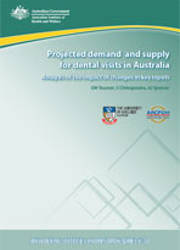Summary
In the early part of the current decade an emerging shortage of dental practitioners was widely recognised by the dental profession and key stakeholders. At this time, the Australian Research Centre for Population Oral Health (ARCPOH) published several reports projecting and examining supply and demand of dental visits in Australia. Since the publication of those projections in 2003, many factors influencing the supply and demand of dental visits in Australia have changed.
Revised baseline projections from the year 2003 are presented. These projections were based on the known circumstances at the time of report writing and hence the revised supply projection does not include new regional dental schools announced at the end of 2007. The sensitivity of these baseline projections are assessed by examining the impact of changes in key inputs or assumptions. The alternative scenarios examined broadly relate to dental labour force policy directions and thereby provide an analysis of their potential impact.
Revised supply projections
- The number of dentists is projected to increase by 33%, from 10,104 dentists in 2005 to 13,465 dentists in 2020.
- Numbers of dental prosthetists and dental therapists are projected to decline slightly by 2020, while numbers of hygienists are projected to increase by 138% of a low base number.
- The total aggregate supply of dental visits is projected to increase by 17% from 28.9 million visits in 2005 to 33.7 million visits in 2020.
Revised demand projections
- Under the ‘no PCD growth’ projection, demand for dental visits is projected to increase from 28.2 million visits in 2005 to 33.6 million visits in 2020 (an increase of 19%). Under the ‘half PCD growth’ and ‘continued PCD growth’ projections, demand in 2020 is projected to be 38.8 and 44.0 million visits respectively.
Supply projections: changes in key inputs
- Supply projections were most sensitive to differing productivity (visits supplied per year) assumptions and changes in levels of dentist recruitment from Australian universities or through migration. They were less sensitive to changes in attrition rates and increases in allied dental recruitment levels.
Demand projections: changes in key inputs
- Demand projections were very sensitive to differing assumptions of future per capita demand (PCD) growth. Conservative and potentially likely increases in percentage accessing care in a 12-month period resulted in substantial increases in projected demand. Demand projections were not very sensitive to changes in insurance coverage or changes in patterns of access by regional dwellers.
Conclusion
Of the various scenarios examined, it was contended that the ‘most likely’ supply scenario was that of 140 additional dentist graduates (from 2013 onwards). This scenario projected that supply in 2020 would be approximately 36.0 million visits. The most likely demand projection was argued to be that of half growth in PCD, which projected that demand would be 38.8 million visits by 2020. These ‘most likely’ supply and demand projections result in an estimated supply shortfall of 2.8 million dental visits. This equates to an under supply of 1,000 to 1,100 dental practitioners (on the basis of current productivity levels).
Preliminary material (75KB PDF): Abbreviations; Symbols; Acknowledgments
1. Introduction (48KB PDF)
- Purpose of this report
- Overview of previous supply and demand projections
- Policy directions or shift in trends
2. Overview of supply and demand models (81KB PDF)
- Supply model
- Demand model
3. Supply of dental visits (223KB PDF)
- Dentist labour force
- Allied dental labour force
- Review of previous dental labour force projections, 2000 to 2010
- Refinement of supply projections
4. Demand for dental visits (81KB PDF)
- Demand for dental care
5. Reconciling supply and demand (63KB PDF)
6. Capacity to supply dental visits: impact of changes in key inputs (225KB PDF)
- Impact of increased numbers of dental graduates
- Changes in numbers of successful ADC candidates
- Changes in dentists' attrition and retention rates
- Shifts in productivity trends
- Summary
7. Demand for dental visits: impact of changes in key inputs (189KB PDF)
- Shifts in patterns of accessing dental care
- Changes in levels of dental insurance coverage
- Increased access to dental care by regional dwellers
- Summary
8. Discussion (67KB PDF)
- Revised supply and demand projections
- Further issues
References (37KB PDF)
Glossary (47KB PDF)
Appendixes
Dental labour force estimates, 2003 (71KB PDF)
Methods: supply projection model (95KB PDF)
Australian university dentistry course commencements and completions (61KB PDF)
Comprehensive tables of dental labour force and supply projections (751KB PDF)
Methods: demand projection model (69KB PDF)
Comprehensive tables of demand projections for dental visits (62KB PDF)
Projected supply of dental visits by multiple scenarios, 2020 (253KB PDF)
End matter: List of tables (45KB PDF); List of figures (40KB PDF)



